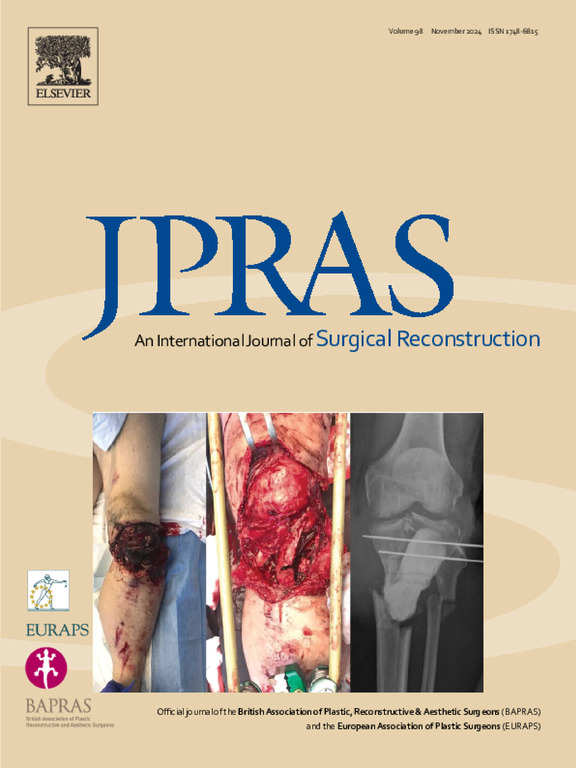A retrospective cohort study: Waterjet-assisted liposuction reduces inflammation but increases the risk of hypokalemia in patients with lipoedema
IF 2.4
3区 医学
Q2 SURGERY
Journal of Plastic Reconstructive and Aesthetic Surgery
Pub Date : 2024-10-13
DOI:10.1016/j.bjps.2024.10.013
引用次数: 0
Abstract
Introduction
Lipoedema is a congenital fat distribution disorder. It leads to a pathological increase in adipose tissue due to a hypertrophy and hyperplasia of the adipocytes. Currently, the disease affects approximately 10% of women. A common treatment of the disease is liposuction to remove the pathologic fat cells.
Patients and Methods
A total of 47 patients (mean age: 62.00 ± 12.96 years) were treated with the conventional tumescent liposuction and 25 patients (mean age of 45.16 ± 12.87 years) with waterjet-assisted liposuction (WAL), a gentle, tissue-conserving method that washes out fat cells. WAL is thought to cause less damage to surrounding tissue than tumescent liposuction and thus, less trauma.
Results
At the postoperative level, the C-reactive protein was significantly (p* = 0.0195) lower after WAL treatment, implying a lower inflammation level than after tumescent liposuction. Also, a decrease of electrolytes such as potassium in the blood serum was observed in some cases. The postoperative potassium level dropped by 0.30 ± 0.24 mmol/l, a value that was significantly lower in WAL-treated patients where the level dropped by 0.47 ± 0.31 mmol/l. The mean fat aspirate using the conventional tumescent method was 3302.13 ± 1345.89 ml and 3727.08 ± 151.96 ml with the WAL treatment.
Conclusions
WAL is a tissue-conserving method that washes out fat cells with less trauma to surrounding tissue as observed with conventional tumescent liposuction. WAL causes a lower inflammation level but higher loss of potassium ions. This latter aspect needs attention after the liposuction treatment.
Trial registration
Waterjet-assisted liposuction reduces inflammation but increases the risk of hypokalemia when compared to conventional tumescent liposuction in patients with lipoedema, DRKS00034711. Registered July 17, 2024 - Retrospectively registered. Trial registration number DRKS00034711.
一项回顾性队列研究:水刀辅助吸脂术减轻了脂肪性水肿患者的炎症反应,但增加了低钾血症的风险。
简介脂肪性水肿是一种先天性脂肪分布障碍。由于脂肪细胞肥大和增生,导致脂肪组织病理性增加。目前,约有 10% 的女性患有此病。该病的常见治疗方法是通过吸脂术去除病理性脂肪细胞:共有 47 名患者(平均年龄:62.00 ± 12.96 岁)接受了传统的膨胀吸脂术治疗,25 名患者(平均年龄 45.16 ± 12.87 岁)接受了水刀辅助吸脂术(WAL)治疗。与抽脂术相比,水刀辅助抽脂术对周围组织的损伤较小,因此创伤也较小:结果:术后 C 反应蛋白在 WAL 治疗后明显降低(p* = 0.0195),这意味着炎症水平低于抽脂术。此外,在一些病例中还观察到血清中钾等电解质的下降。术后血钾水平下降了 0.30 ± 0.24 mmol/l,而 WAL 治疗患者的血钾水平明显降低了 0.47 ± 0.31 mmol/l。使用传统抽吸法抽吸的脂肪平均为 3302.13 ± 1345.89 毫升,而使用 WAL 治疗抽吸的脂肪平均为 3727.08 ± 151.96 毫升:WAL是一种保护组织的方法,与传统的膨胀吸脂法相比,WAL在洗出脂肪细胞时对周围组织的创伤更小。WAL 造成的炎症水平较低,但钾离子流失较多。吸脂治疗后需要注意后一个方面:水刀辅助吸脂术与传统的抽脂术相比,可减少脂肪性水肿患者的炎症反应,但会增加低钾血症的风险,DRKS00034711。2024年7月17日注册 - 追溯注册。试验注册号 DRKS00034711。
本文章由计算机程序翻译,如有差异,请以英文原文为准。
求助全文
约1分钟内获得全文
求助全文
来源期刊
CiteScore
3.10
自引率
11.10%
发文量
578
审稿时长
3.5 months
期刊介绍:
JPRAS An International Journal of Surgical Reconstruction is one of the world''s leading international journals, covering all the reconstructive and aesthetic aspects of plastic surgery.
The journal presents the latest surgical procedures with audit and outcome studies of new and established techniques in plastic surgery including: cleft lip and palate and other heads and neck surgery, hand surgery, lower limb trauma, burns, skin cancer, breast surgery and aesthetic surgery.

 求助内容:
求助内容: 应助结果提醒方式:
应助结果提醒方式:


